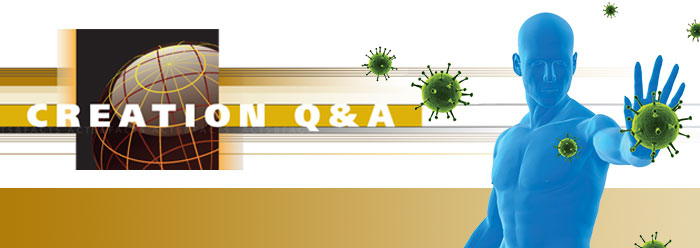by Randy J. Guliuzza, P.E., M.D., and Frank Sherwin, M.A.*
If God originally created the world without death and disease, where did our bodies get their disease-fighting capabilities? Christians generally explain the origin of immune systems in three ways. These explanations, though, have theological and scientific snags.
- Humans somehow developed immune systems after the Fall. However, this life-preserving system is so elaborate that any natural development is unlikely.
- God supernaturally infused Adam, Eve, and living creatures with immune systems after the Fall. While this is possible, since Scripture allows post-Fall interventions, it is unlikely because immune systems are so extensive and complex that infusion would entail broad creation-like formations that Scripture indicates had ceased at the end of the creation week.
- Since God foreknew the Fall, He hid in Adam a latent immune system whose activation was mediated by post-Fall conditions. However, explanations that only work by invoking God’s omnipotence/omniscience do not truly explain anything since, obviously, they can explain everything. In addition, no known scientific tests unambiguously detect mediating interventions by either God or environmental conditions.
Creationists need biblical explanations that are scientifically sound and not simply lighter versions of evolutionary lines of thinking. So, one way to begin is by asking: Does our immune system serve any non-disease-fighting purposes today? Yes, it does.
Our immune system breaks down cells that have reached the end of their programmed duration. Why should we view some cells as having a pre-specified existence? Because we can identify machinery and programming within those cells that enable them to self-destruct upon reaching specified conditions.
However, the core dilemma is the immune system’s relationship to microbes. Are there immunological functions that include the destruction of microbes for an entirely different purpose than to protect us from disease? Yes, there are.
Researchers have mapped many unique microbial communities on or in our bodies, such as our mouth, gut, airways, and skin. We call our collection of microscopic viruses, bacteria, and fungi our microbiome. Our relationship to our microbiome is quite intimate since it accomplishes vital tasks for us—a fact likely true for Adam before the Fall. This is no trivial collection—researchers estimate that ten times as many microbes live on us and in our gastrointestinal tract as the 100 trillion cells that compose our bodies.
One exciting aspect of microbiomes is that they constantly change as we experience different conditions like diet and travel. From a design standpoint, when two distinct dynamic entities interface closely with each other, at least one has systems that enable that successful relationship. Thus, we should look for systems facilitating the human-microbiome interface.
From the human side, research shows how our immune system regulates our dynamic microbiome. One study revealed how immune factors regulate the different types of microbes in our guts.1 In flies, another study disclosed that a gene controlling embryo development also had a surprising function maintaining the balance of immunological elements regulating specific microbes.2 These researchers noted that virtually all organisms with a gut have similar features.
It could be that dynamic microbiomes regulated by dynamic immune systems might enable creatures to be fruitful, multiply, and fill a dynamic earth as God commanded in Genesis 1:22, 28—and in the process display some impressively designed capacities by adjusting to new niches. A study demonstrated how some woodrats rapidly filled a new environmental niche when they began consuming normally toxic creosote plants aided by the detoxification metabolic processes of their well-regulated microbiome. The researchers concluded, “These results demonstrate that microbes can enhance the ability of hosts to consume PSCs [plant secondary compounds] and therefore expand the dietary niche breadth of mammalian herbivores.”3
The immune system’s phenomenal regulation of our microbiome allows us to appreciate a higher level of design when systems of two independent entities work together in a seamless operation. A reasonable conclusion is that they were, and are, designed to work together.4
Certainly, the Fall caused perversions of some once-symbiotic relationships to become pathogenic. These two functions of our immune system—internal maintenance and regulation of our microbiome—involve microbe destruction but can operate for purposes other than disease protection.
References
- Salzman, N. H. et al. 2010. Enteric defensins are essential regulators of intestinal microbial ecology. Nature Immunology. 11 (1): 76-83.
- Ryu, J-H. et al. 2008. Innate Immune Homeostasis by the Homeobox Gene Caudal and Commensal-Gut Mutualism in Drosophila. Science. 319 (5864): 777-782.
- Kohl, K. D. et al. 2014. Gut microbes of mammalian herbivores facilitate intake of plant toxins. Ecology Letters. 17 (10): 1238-1246.
- Thomas, B. Were Intestines Designed for Bacteria? Creation Science Update. Posted on icr.org October 8, 2014, accessed October 30, 2014.
* Dr. Guliuzza is ICR’s National Representative, and Mr. Sherwin is Research Associate, Senior Lecturer, and Science Writer at the Institute for Creation Research.














